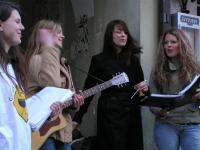memory
DO YOU SPEAK GERMAN? DO YOU SPEAK LITHUANIAN? DO YOU SPEAK ENGLISH? JUST ENOUGH THAT SOMEONE ELSE COULD READ THIS TEXT IN GERMAN OR FRENCH LITHUANIAN AND COULD GET SOME IDEA? PLEASE TRY - OTHERWISE THERE IS NO TRANSLATION FOR THIS TEXT .
/////////////////////////////////////////////////////////////////
The women are seen to have in their hands small books which they say are feminaries. These are either multiple copies of the same original or else there are several kinds. In one of them someone has written an inscription which they whisper in each other’s ears and which provokes them to full-throated laughter. When it is leafed through the feminary presents numerous blank pages in which they write from time to time. Essentially, it consists of pages with words printed in a varying number of capital letters. There may be only one or the pages may be full of them. Usually they are isolated at the centre of the page, well spaced black on a white background or else white on a black background.
(...)
They say, how to decide that an event is worthy of remembrance? Must Amaterasu herself advance on the forecourt of the temple, her face shining, blinding the eyes of those who, prostrate, put their foreheads to the ground and dare not lift their heads? Must Amaterasu raising her circular mirror on high blaze forth with all her fires? Must the rays from her slanting mirror set fire to the ground beneath the feet of the women who have come to pay homage to the sun goddess, the greatest of the goddesses? Must her anger be exemplary?
(...)
The women look at the old pictures, the photographs. One of them explains. For instance the series of the textile factory. There is a strike that day. The women workers form a picket line in the field where the buildings are sited. They move in a circle one behind the other singing stamping their feet on the ground clapping their hands. They have black blouses and woollen scarves. All the windows, all the doors of the factory are closed. One or other of them carries at arm’s length a placard on which slogans are written, painted in red on the white paper. Under their feet in the field is a circle of beaten earth.
Or else someone comments on the series of photographs of demonstrations. The women demonstrators advance all holding a book in their upraised hands. The faces are remarkable for their beauty. Their compact mass bursts into the square, quickly but without violence, borne by the impetus intrinsic to its size. Great commotions take place at various points in the square when the demonstrators attempt to halt around groups of one or more speakers. But they are immediately pushed dragged along by the thousands of young women who follow them and who stop in their turn. Despite the disturbance of the general order created by individual movements there is no trampling underfoot, there are no shouts, there are no sudden violent rushes, the speakers are able to stay put. At a certain point the whole crowd begins to come to a halt. It takes some time for it to come to a complete standstill. Over to one side speeches have commenced, voices over the loud-speakers claim the attention of the demonstrators. "
(...)
Their peregrinations are cyclical and circular. Whatever the itinerary, whatever point of departure they choose, they end up at the same place. The paths are parallel, equidistant, narrower and narrower as they approach the centre of the figure. If they follow the path from the interior to the exterior they must traverse the widest of the circles before finding the cross-passage that leads them to the centre. The system is closed. No radius starting from the centre allows of any expansion or of breaking through. At the same time it is without limit, the juxtaposition of the increasingly widening circles configures every possible revolution. It is virtually that infinite sphere whose centre is everywhere, circumference nowhere.
(...)
Les GuÈrillËres, Monique Wittig
Translated from the French by David Le Vay
Originally published by Les Editions de Minuit, 1969
In English by Beacon Press, 1985.
©2007 /ubu editions http://www.moniquewittig.com/index.html
